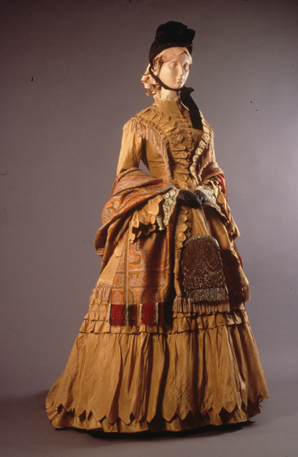|
IN January, 1901, the Governors of
the Incorporated Weaving, Dyeing, and Printing College of Glasgow organized
a Special Loan Exhibition of Paisley Shawls and similar fabrics, principally
for the instruction of their students. These exquisite productions are now
neither worn nor manufactured here, but many are cherished as heir-looms in
families in the West of Scotland and elsewhere. One of the last acts of Her
Majesty Queen Victoria was to direct two beautiful specimens to be sent to
this Exhibition, thus renewing that interest which, particularly in its
darkest days, Her Majesty had always taken in the Paisley Shawl Trade.

Wedding dress, ca. 1872-76,
Transferred from the Allen Memorial Art Museum, Oberlin College, Oberlin,
OH, Gift of Mr. and Mrs. E. P. Vance, 1970, KSUM 1995.17.57;
Paisley
shawl, ca. 1850-55, Silverman/Rodgers Collection, KSUM 1983.1.1498;
Photograph ©
Kent State University Museum
The Exhibition attracted much attention because of the
artistic beauty of the shawls, and the high degree of technical skill and
patient care on the part of the weavers which they exhibited. Among the
visitors were many artists, some of whom came from the large industrial
centres of England. At the time a very general desire was expressed that
some more permanent exhibition of these beautiful fabrics should be placed
in one of the local museums.
A
hope was also entertained that some account of this industry might be
written, as the period in the history of the town in which it was carried on
was one of singular interest, not only on account of the merit of the
articles produced, and the high talent shown in their manufacture, but for
the marked influence which the conditions of the employment had upon the
character of the work-people engaged in it.
The writer was urged by friends to undertake this task.
Brought up in the trade, he entered business life at the time when the
industry began to decline. He thus witnessed the decay and extinction of the
Paisley Shawl trade; and because of the consequent distress and lack of
employment, had, like many other Paisley boys of that period, to go
elsewhere to earn a living. Returning after an absence of more than forty
years, he finds everything changed. The weavers are almost extinct. Not a
draw-loom exists in the town. The very memory of the shawl trade is
well-nigh lost. The present generation is engaged on other and more varied
occupations, and, perhaps in consequence, the town has become one of the
most prosperous in the kingdom.
The epoch of the Shawl Trade in Paisley is now rounded
off. Like a flower it came up, blossomed, and decayed. Its history is full
of honour to the town, and pregnant with lessons that should never be
forgotten.
These pages are
written with the desire to keep alive an interest in this noble past, by
placing on record some description of these beautiful fabrics, as well as of
the remarkable class of men who produced them, and who have now nearly all
gone over to the majority.
In
carrying out a task so congenial to his feelings, the writer has to
acknowledge with warmest thanks the valuable assistance which he has
received from Mr. John Ingram of Messrs. T. & D. Wilson & Co., of Glasgow,
and Mr. Thomas Brown, Chief Instructor in the Incorporated Weaving. Dyeing,
and Printing College of Glasgow, both of whom, in early life, had practical
experience of the labours of the draw-boys and weavers of Paisley. He has
also to express his thanks to the ladies who have so kindly allowed him to
reproduce, in coloured illustrations, such beautiful examples of what has
become widely known as the Paisley Shawl.
THE
MOORINGS,
TH0RNLY PARK, PAISLEY,
December, 1903.
Contents
Chapter I - Early Textiles in
Paisley
Chapter II - The Paisley Shawl
Chapter III - Design of the
Shawl - The Pine Pattern
Chapter IV - Preparation of the Loom
Chapter
V - Weaving of the Harness Shawl
Chapter VI - Culture and Skill of the
Weavers
Chapter VII - Influence of the Town and Surroundings
Chapter
VIII - The Draw-Boys
Chapter IX - National and Local Politics
Chapter
X - Literary Efforts of the Weavers
Chapter XI - Some well know Paisley
Men
Chapter XII - Decay of the Shawl Trade - Conclusion
The Paisley
Directory and General Advertiser for 1911-12
Including comprehensive and accurate directories for Renfrew, Linwood,
Johnstone, Howwood, Elderslie, Kilbarchan, Inkermann, Brookfield, Blackston,
Barrhead, Clippens and Neilston. (pdf) |

